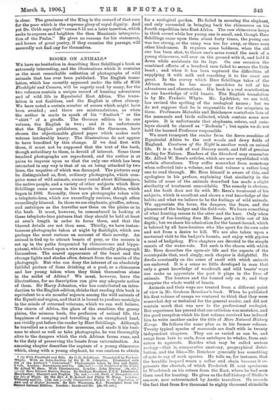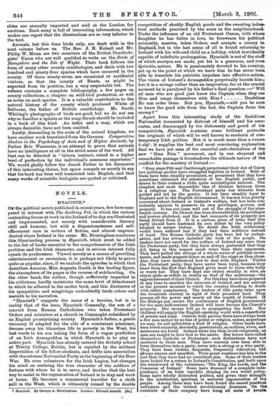BOOKS ON ANIMALS.* WE have no hesitation in describing Herr
Schillings's book as extremely interesting, and the illustrations which it contains as the most remarkable collection of photographs of wild animals that has ever been published. The English trans- lation, which has recently appeared under the title of With Flashlight and Camera, will be eagerly read by many, for the two volumes contain a unique record of hunting adventures and of wild, life in Equatorial East Africa. The trans- lation is not faultless, and the English is often clumsy. We have noted a certain number of errors which might have been avoided ; and there are mistranslations, as when the author is made to speak of his " flintlock " or the " shirt " of a giraffe. The German edition is in one volume, the English in two ; and it is unfortunate that the English publishers, unlike the Germans, have chosen the objectionable glazed paper which makes each volume intolerably heavy. The illustrations do not appear to have benefited by this change. If we deal first with these, it must not be supposed that the text of the book, though subsidiary to them, is devoid of interest. Some three hundred photographs are reproduced, and the author is at pains to impress upon us that the only one which has been retouched in any way is that of an ox being attacked by two lions, the negative of which was damaged. The pictures may be distinguished as, first, ordinary photographs, which corn- prise some of wild animals, scenery round about Kilimanjaro, the native people, and a variety of other subjects which Herr Schillings came across in his travels in East Africa, which began in 1896. Secondly, there are photographs taken with a. telephoto-lens, which are exceedingly curious, though often exceedingly blurred. In these we see elephants, giraffes, zebras, and antelopes as the traveller saw them on the plains or in the bush. It must, however, be remembered in looking at these telephoto-lens pictures that they should be held at least at arm's length in order to focus them, and that the blurred details are not then seen. Thirdly, we have instan- taneous photographs taken at night by flashlight, which are perhaps the most curious on account of their novelty. Art animal is tied up to attract beasts of prey, or the camera is set up in the paths frequented by rhinoceroses and hippo- .. potami, which tread upon a wire and automatically photograph themselves. The scared appearance of the beast and the strange lights and shades often detract from the merits of the photograph. But who can deny the interest of an absolutely faithful picture of lions drinking at a pool, or a rhinoceros and her young taken when they think themselves alone in the midst of Africa ? We must, however, leave the illustrations, for no description can give any adequate notion of them. Sir Harry Johnston, who has contributed an intro- duction to the English edition, thinks that reading this book is equivalent to a six months' sojourn among the wild animals of the Equational region, and that it is bound to produce nostalgia in the minds of returned veterans, which we can well believe. The charm of Africa, the glare of the sunshine, the grassy plains, the mimosa bush, the profusion of animal life, the happiness of camping and travelling in an unexplored land, are vividly put before the reader by Herr Schillings. Although he travelled as a collector for museums, and made it his busi- ness to shoot as well as take photographs, he was thoroughly alive to the dangers which the rich African fauna runs, and to the duty of preserving the beasts from extermination. An amusing chapter describes the capture of a young rhinoceros which, along with a young elephant, he was anxious to obtain • (1) With Flashlight and Rifle. By C. G. Schillings. Translated by Frederic Whyte. With an Introduction by Sir H. H. Johnston. Illustrated with 302 of the Author's " Untouched " Photographs taken by Day and Night. 2 O ols. London : Hutchinson and Co. [24s. net.]—(2) Creatures of the Night. By Alfred W. Rees. With Illustrations. London : John Murray. [6s. net.] —(3) More Natural History Essays. By Graham Renshaw, F.Z.S. Illustrated. Manchester: Sherratt and Hughes. [6s. net.]—(4) Birds of Hampshire and the Isle of Wight. By the Rey. J. E. Relsall and Philip W. Munn. London : Witherby and Co. [Ms. net.]--(5) Comparative Studies in the Psychology of Ants and of Higher Animate. By Eric Wesmann, 5.3. Translated from the &cone German Edition. London: Sands and Co. [is. 6d. net.] for a zoological garden. He failed in securing the elephant, and only succeeded in bringing back the rhinoceros on his fourth expedition into East Africa. The cow rhinoceros keeps in thick covert while her young one is small, and, though Herr Schillings came upon them about forty times, the young one was too strong, or the camp was too far away, or there were other hindrances. It requires some boldness, when the old one has been shot, to throw one's arms round the neck of a young rhinoceros, roll over on the ground with it, and hold it down while assistants tie its legs. On one occasion the combined efforts of a hundred men failed to secure the little beast ; and when it has been captured the difficulties of supplying it with milk and marching it to the coast are great. In the survey which Herr Schillings takes of the African fauna he has many anecdotes to tell of his adventures and observations. His book is a real contribution to our knowledge of wild beasts. The English translation is by Mr. Frederic Whyte. Mr. Lydekker, we are told, has revised the spelling of the zoological names ; but we do not suppose that be is responsible for the misprints in them. Professors Matschie and Reichenow contribute lists of the mammals and birds collected, which contain some new species. It is unfortunate that elephants, zebras, and ante- lopes should be classed as " Rodents " ; but again we do not hold the learned Professor responsible.
We must transport the reader from the fierce sunshine of Equatorial Africa to the cool woods and dewy fields of England. Creatures of the Night is another work on animal life. It is a book of real literary merit, and full of genuine feeling for Nature. Readers of the Standard may remember Mr. Alfred W. Rees's articles, which are now republished with certain alterations. They suffer somewhat from monotony when collected into a volume, and that volume a rather long one to read through. Mr. Rees himself is aware of this, and apologises in his preface, explaining that similarity in the habits of some of the animals described has made a slight similarity of treatment unavoidable. The remedy is obvious, and the fault does not. lie with Mr. Rees's treatment of his subjects, which is excellent and shows a real knowledge of the habits and what we believe to be the feelings of wild animals. We appreciate the loves, the dangers, the fears, and the pleasures of the badger and the field-vole. We learn something of what hunting means to the otter and the hare. Only when writing of fox-hunting does Mr. Rees get a little out of his depth ; but we share his admiration for the basset-hound, which is beloved by all hare-hunters who like sport for its own sake and not from a desire to kill. We are also taken upon a nocturnal visit to the badger's haunts, and enjoy with gipsies a meal of hedgehog. Five chapters are devoted to the simple annals of the water-vole. Yet such is the charm with which Mr. Rees describes the open-air life and the aspects of the countryside that, read singly, each chapter is delightful. He dwells constantly on the sense of smell with which animals are endowed. It is a sense so little developed in man that only a great knowledge of woodcraft and wild beasts' ways can make us appreciate the part it plays in the lives of animals. The hunters and the hunted rely on it; and they comprise the whole world of beasts.
Animals and their ways are treated from a different point of view in Mr. Graham Renshaw's book. When he published his first volume of essays we ventured to think that they were somewhat dry or technical for the general reader, and did not contain much that was new to the professional zoologist. But experience has proved that our criticism was mistaken, and the good reception which his first volume received has induced' him to write another under the title of More Natural History Essays. He follows the same plan as in his former volume. Twenty typical species of mammals are dealt with in twenty independent chapters. They are as varied as can be, and range from bate to seals, from antelopes to whales, from ant- eaters to squirrels. Besides what may be called serious zoology—that is, comparative anatomy, geographical distri- bution, and the like—Mr. Renshaw generally has something of note to say of each species. He tells us, for instance, that the heraldic leopard wears a collar and chain because it re- presents the cheetah, of which Frederick IL sent specimens to Woodstock on his return from the East, where he had seen them used for hunting. He gives us the full history of Steller's sea-cow, now exterminated by Arctic travellers. He records the fact that from five thousand to eighty thousand chinchilla
skins are annually imported and sold at the London fur auctions. Each essay is full of interesting information, which makes one regret that the illustrations are so very inferior to the text.
Animals, but this time birds only, are dealt with in the next volume before us. The Rev. J. E. Selsall and Mr. Philip W. Munn are two members of the British Ornitholo- gists' Union who are well qualified to write on the Birds of Hampshire and the Isle of Wight. Their book follows the form of many other county ornithologies, and deals with two hundred and ninety-four species which have occurred in the county. Of these ninety-seven are occasional or accidental visitors, so that the county of Hants, as might be expected from its position, has a very respectable list. The volume contains a complete bibliography, a few pages on county collections, a chapter on wild-bird protection, as well as notes on each species. It is a valuable contribution to the natural history of the county which produced White of Selborne, the father of British ornithology. Mr. Smith Whiting's photographs of birds are good, but we do not see why so familiar a species as the song-thrush should be included in a book of this kind. An index and a map, which are always desirable, have not been omitted.
Lastly, descending in the scale of the animal kingdom, we have another work translated from the German. Comparative Studies in the Psychology of Ants and of Higher Animals, by Father Eric Wasmann, is an attempt to prove that animals have no intelligence at all in the strict sense of the word. All that can be detected is "inborn instinct, raised to a higher level of perfection by the individual's sensuous experience." We would gladly follow the Jesuit Father in his discussion of this interesting theme, but space compels us merely to say that his book has been well translated into English, and that many works of scientific biologists are quoted or criticised.















































 Previous page
Previous page